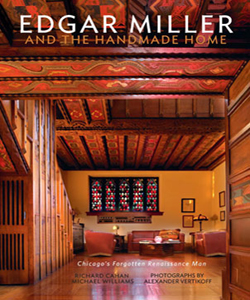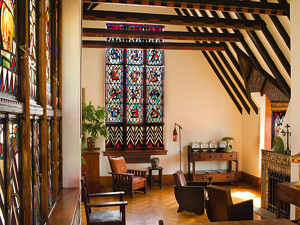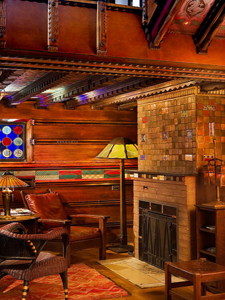Edgar Miller and the Handmade Home
January 19th, 2011“Best of Chicago Art Magazine” series. Originally appeared on the site 9/21/2010
Ed McDevitt
When my wife was approaching a birthday she found insignificant but which the rest of us decided to celebrate, our son arranged to hold the party in a courtyard and apartment at 155 West Burton Place in Chicago. The apartment owners are friends and patrons of his at the tavern at which he works, Burton Place on Wells Street, half a block west.
The courtyard is one of several among a series of apartment units. It is a private complex, entered only through a locking gate. As we awaited entry, we stood on a walkway that was a riot of colored tiles which had seemingly spilled out of the inner walkway into Burton Place. On the exterior wall just east of the gate is a mosaic address panel with “155″ on it next to a recessed plaque that says, “Original Carl Street Studios Erected 1927 by Sol Kogen,” a statement, it turns out, of half-fact. Surrounding the gateway are quarter-round column-like structures decorated with repeating reliefs that for all the world appear to be oversized hieroglyphs. I stepped back for a moment and looked east again, noting the oriel window bay a short distance away, especially the carved animal panels on the spandrels. My son had told me that this had been an “artists’ colony” from the Depression, information that did not prepare me for what I saw.
We were walking into one of artist Edgar Miller’s hand-made home masterpieces, as it turned out. I was fascinated by the work surrounding us, and even more awe-struck when we entered studio (the proper name for the apartments) belonging to our son’s friend. It was like nothing any of us had ever seen, utterly unique, clearly a total work of art: stained glass, carved staircase ornament, elaborate brickwork, carved doors, mosaics. Had we not been otherwise occupied with eating, drinking wine and beer, and celebrating, we all would have been acting as if we were in a living gallery. But we were, indeed, otherwise occupied, and each marveled in her/his own way at our surroundings as the day’s light diminished. The studio owners probably mentioned Edgar Miller, but it did not register fully at the time.
Several months later I happened to attend a Chicago Architecture Foundation Noontime Lecture that featured Richard Cahan, Michael Williams and Alexander Vertikoff, whose book “Edgar Miller And The Handmade Home” had just been published. They spent their 45 minutes talking about Edgar Miller, his art and his life. I did not immediately connect the subject of their talk with what I’d seen at 155 West Burton Place, but the moment the first slide popped onto the screen, I experienced the shock of recognition.
As they do in their book, they told the very touching story of Miller’s last public appearance at an earlier Chicago Architecture Foundation Noontime Lecture in May, 1993, a lecture about his life. He had been in poor health and had apparently lost cognitive function, not having spoken a coherent sentence in weeks prior to this event. When someone suggested that he be allowed to tell some of his own story, he rallied and spoke lucidly of his life and art for the rest of the hour; but that night he had a massive stroke, probably brought on by the exertion at the lecture, and died on June 1, 1993. They then brought alive the stupendous output of this amazing man.
Their beautifully prepared and researched book brings back into our consciousness a most important Chicago artist and artisan who had been pretty much forgotten. The authors worked with a small cadre of Miller aficionados who have kept the Miller flame burning, however weakly, for many years. The biography they present depicts a man of enormous talent, enormous individuality, and stunning concentration and focus in his work.The photography by Alexander Vertikoff places him among the great photographers of buildings and their spaces, in the class of masters like Hedrich Blessing.
Miller taught himself to be a woodworker, carver and furniture maker, a ceramicist, a stained glass and window maker, and many other things. His training, such as it was (he threw himself out of more than one school, including the Art Institute of Chicago), was in multiple arts, including painting, sculpture, and glass work.
His greatest work came in his transformations of existing buildings. While his collaboration with Sol Kogen was troubled, their partnership beginning in 1927 with the Carl Street (renamed Burton Place in 1936) in 1927 and continuing through 1935 established Miller as what best can be called a “total artist.” Their work at 1734 North Wells Street, another rehabbing to create artists’ studios, as Carl Street had been, ended their partnership but the two projects were the inspiration for a sort of rehabbing industry that developed in Chicago during and after the Depression.
But therein lies the reason Miller is not as well known as other artists of his time: much of his work is hidden from view inside private homes and buildings. What this book does it to present large amounts of that wonderfully elaborate hand-work for all of us to see. If one mines it carefully, one can also identify places other than Burton Place and 1734 North Wells where one could see publicly available instances of Miller’s art: the finials atop St. Thomas the Apostle Church in Hyde Park; the leadwork above the doors at Century Tower (formerly Trustees System Service Building) at 182 West Lake; the Walter Guest Apartments facade and brick wall, 2150 North Cleveland; the carvings, castings, stained glass windows and the front facade of the Fisher Apartments at 1209 North State Pkwy.
For some this fine book would be a dust-gatherer under the glass of the coffee table. For aficionados of Chicago’s art heritage it is an essential volume. It is currently the only comprehensive biography of Edgar Miller and the one compendium of his artistic output that we have. Fortunately, it revives the memory of Miller and stops his disappearance into the forgotten corners of history. For that we can be grateful. It is also fortunate that the presentation of the information and art is of such high quality.
Share This!
Follow me
Subscribe to my podcast
Tags: architecture, chicago architecture, chicago art magazine, edgar miller, edgar miller architecture








